Figures & data
Figure 1. Flow chart of the transitions between the host and vector compartments. The birth and death of hosts and vectors are not explicitly shown for the sake of clarity.
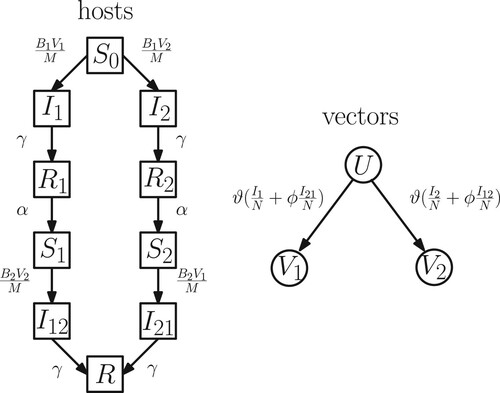
Figure 2. The range corresponding to 0, 1 or 2 coexistence equilibria (the dashed vertical line is the set with
such that
. The shaded area shows the pairs
with a locally asymptotically stable interior equilibrium (eigenvalues computed numerically). The parameter values are given in Table and
.
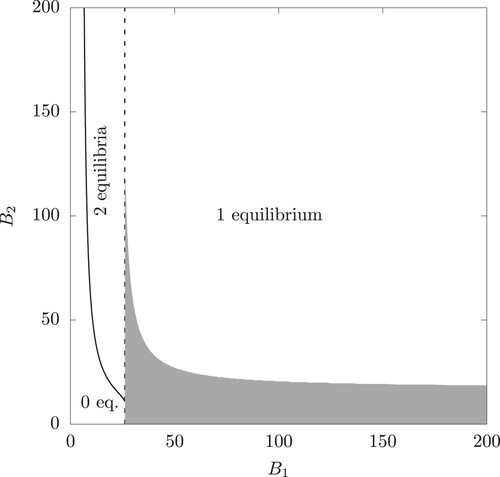
Table 1. Parameter values, most after [Citation1,Citation22] for the host-only model (A1) and [Citation29] for the host-vector model.
Table 2. List of bifurcation types.
Figure 3. Two-parameter bifurcation diagram for the range
and
. One Hopf bifurcation converges for
to the ϕ parameter value [†] for the model of [Citation4] for (a) the host-only model (A1) from [Citation1] and (b) the host-vector model (1). [*] marks the value
in [Citation18].
![Figure 3. Two-parameter (ϕ,α) bifurcation diagram for the range ϕ∈[0,12] and α∈[0,250]. One Hopf bifurcation converges for α→∞ to the ϕ parameter value [†] for the model of [Citation4] for (a) the host-only model (A1) from [Citation1] and (b) the host-vector model (1). [*] marks the value ϕ=2.5 in [Citation18].](/cms/asset/c1ed4faf-304e-454e-9139-0b84398c3c68/tjbd_a_1864038_f0003_oc.jpg)
Figure 4. Two-parameter bifurcation diagram for the range
and
(a) for the host-only model (A1) and (b) for the host-vector model (1).
![Figure 4. Two-parameter (ϕ,α) bifurcation diagram for the range ϕ∈[0,1.3] and α∈[1,7] (a) for the host-only model (A1) and (b) for the host-vector model (1).](/cms/asset/72044b7b-6799-40aa-86b3-a867d8fb11a5/tjbd_a_1864038_f0004_oc.jpg)
Figure 5. One-parameter diagram for ϕ where and B = 52. Equilibria or maximum and minimum values for limit cycles for total infected I (a) for the host-only model (A1) and (b) for the host-vector model (1). Red indicates stable and blue unstable solutions.
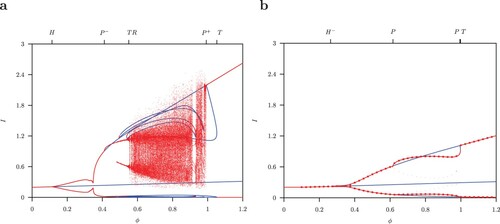
Figure 6. (a) Infected classes (red),
(blue) unstable symmetric solutions for the limit cycle with parameter values
,
, B = 52 and normalized time for one period. (b) Infected classes
(red),
(blue) and
(green),
(pink) solutions for the two stable S-conjugate limit cycles.
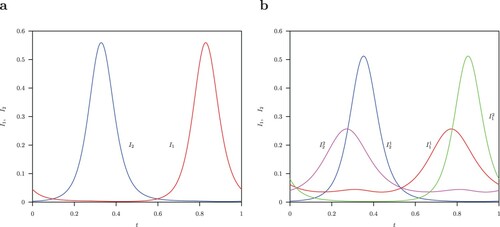
Figure 7. Two-parameter bifurcation diagram with parameter
of (a) the system (1), and (b) the QSSA system where the fast variables
are assumed to be in steady state (Equation9
(9a)
(9a) ). TC curve is for values
. Left of TC there is stable disease-free equilibrium where I = 0. Between the TC and H curve, there is a stable endemic equilibrium, and beyond H, there is a stable limit cycle. No pitchfork bifurcation P is observed in this parameter region.
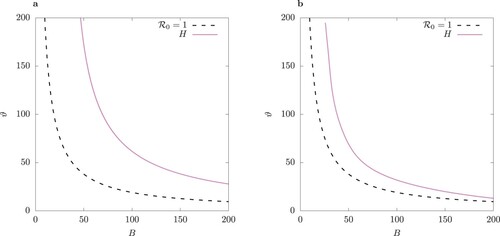
Figure 8. Two-parameter bifurcation diagram with parameter
of (a) the system (1), and (b) the QSSA system where the fast variables
are assumed to be in steady state (Equation9
(9a)
(9a) ). TC curve is for values
. Left of TC there is stable disease-free equilibrium where I = 0. Between the TC and H curve there is a stable endemic equilibrium, and between H and P, there is a stable limit cycle. Inside the region bordered by P, there is bistablity: a pair of S-symmetric limit cycles.
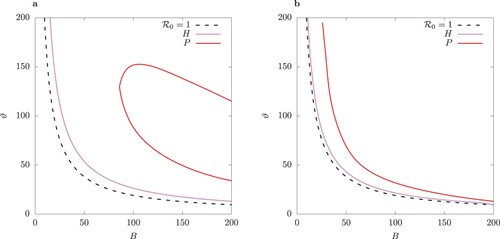
Figure 9. Two-parameter bifurcation diagram with parameter
of (a) the system (1), and (b) the QSSA system where the fast variables
are assumed to be in steady state (Equation9
(9a)
(9a) ). TC curve is for values
. Left of TC there is stable disease-free equilibrium where I = 0. Between the TC and H curve, there is a stable endemic equilibrium, and between H and P, there is a stable limit cycle. Inside the region bordered by P, there is bistablity: a pair of S-symmetric limit cycles.
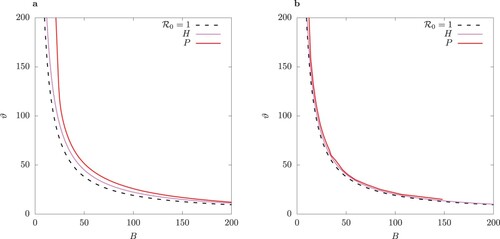
Figure 10. One-parameter bifurcation diagram for B for the case of equal infection rates in the host-vector model (1) (column (a)), and the QSSA model (column (b)). Solid lines indicate stable and dashed lines unstable solutions. Above the Hopf bifurcation point the minima and maxima for limit cycles are shown for total infected I for
.
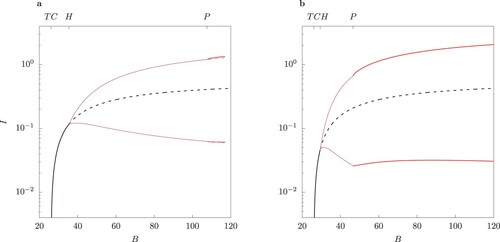
Figure 11. One-parameter bifurcation diagram for B for the case of equal infection rates in the host-vector model (1) (column (a)) and the QSSA model (column (b)). Solid lines indicate stable and dashed lines unstable solutions. Above the Hopf bifurcation point the minima and maxima for limit cycles are shown for total infected I for
.
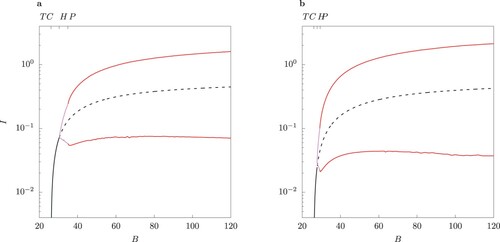
Figure 12. (a) One-parameter bifurcation diagram in B for the case when
. Observe that in the range where two interior equilibria occur, both are locally asymptotically unstable. The dot ° marks the value of B where the two-strain equilibrium undergoes a subcritical Hopf bifurcation. (b) Phase portrait for B = 25.6 for two trajectories starting near the two unstable equilibria, marked by a dot °. The orange curve shows an epidemic with a single peak, later converging to extinction. Observe the oscillatory behaviour in the vicinity of the unstable limit cycle (red curve). c Phase portrait for B = 39.979. The trajectory follows an irregular regime.

Figure 13. One-parameter diagram for ϕ where and B = 52. Equilibria or maximum and minimum values for limit cycles for total infected I for (a) the host-only model [Citation22] and (b) the host-vector model (1). Red indicates stable and blue unstable solutions.
![Figure 13. One-parameter diagram for ϕ where α=52 and B = 52. Equilibria or maximum and minimum values for limit cycles for total infected I for (a) the host-only model [Citation22] and (b) the host-vector model (1). Red indicates stable and blue unstable solutions.](/cms/asset/23f5d10b-baaf-4d5b-885f-0f6196077754/tjbd_a_1864038_f0013_oc.jpg)
Figure 14. Plot of the limit cycle trajectory. Colour coding: full model (red), QSSA model (blue), asymptotic expansion to second order in ε (black). Parameter values listed in Table and (a) , (b)
, and (c)
.

Figure 15. Two-strain non-autonomous host-vector model (1) and (Equation3(3)
(3) ) with B = 52. Torus bifurcation TR bifurcation exist at the same position as the Hopf H for the autonomous system (1), shown in Figure (b). L: limit cycle, C: complex dynamics. Details for the range
are shown enlarged in b.
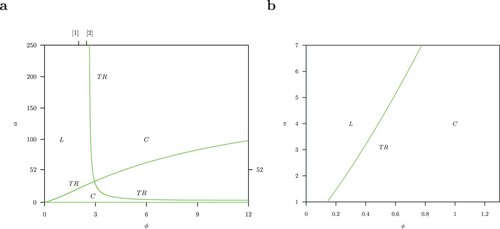
Figure 16. Two-strain non-autonomous (a) host-only model (A1) and (b) host-vector model (1) with parameter , with
and
respectively. For model (1) in forcing function (3)
and
and in asimilar way for model (A1) in the forcing function in [Citation2], Equation (2)
and
. The bullets in (b) mark the globalmaximum and minimum values for limit cycles for total infected I. Red indicates stable and blue unstable solutions.
![Figure 16. Two-strain non-autonomous (a) host-only model (A1) and (b) host-vector model (1) with parameter α=2, with β=104 and B=52 respectively. For model (1) in forcing function (3) M0=10000 and η=0.1 and in asimilar way for model (A1) in the forcing function in [Citation2], Equation (2) β0=104 and η=0.5. The bullets in (b) mark the globalmaximum and minimum values for limit cycles for total infected I. Red indicates stable and blue unstable solutions.](/cms/asset/2a1028a3-db9f-4be5-89b3-643f32eb2d7e/tjbd_a_1864038_f0016_oc.jpg)
